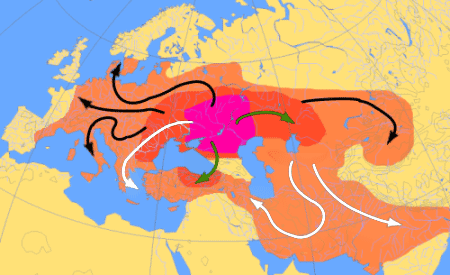1. Even the traditionalists had noted in their works the possibility of older origins of the IE, although they didn't dare to describe those possible older stages of the language.
Today, a general Three-Stage Theory describes how the IE history can be divided into three main layers or Stages (more or less artificial, as it tends to assume that there were no significant intermediate stages): one, the common (immediate) ancestor of the Indo-European proto-languages, that which had been searched for from the beginning, The IE, which now will be called IE III (also called Late PIE) and also Europaio in this Grammar. The second stage corresponds to the splitting of - at least - the Anatolian and IE III from their common source, IE II (Middle PIE). What is called IE I or Proto-Indo-European, PIE for short (Early PIE), is the ancestor of IE II; there is, however, no common position as to how it was like.
NOTE. It is impossible to trace back a single work that reveals the three stages, as the Theory developed from the very origins of the IE studies, and it was not until the Anatolian writings were discovered and read (already in this century) that this Theory could be rightly developed. We don't believe a single scholar to have made the whole Theory, but that multiple contributions have helped to achieve this (now) general Assumption.
2. Another division has to be made, however, so that the Europaio concept is properly understood. The IE III language split up early into two main dialects, (probably) the Northern and Southern - as we will call them from now on when necessary-, both of them are called IE III as a whole. As far as we know, the Northern later split up (we cannot exactly know the how and when of each dialect) in at least Tocharian, Germanic, Celtic, Latin, Baltic and Slavic, the last two sometimes referred to as Baltoslavic, for their shared features. The Southern split mainly in Greek and Indo-Iranian.
 Sample Map of the IE languages expansion 4000-1000 BC, according to the Kurgan and Three-Stage hypothesis. In purple, the Yamna culture corresponding to PIE (4000-3500). In dark red and green arrows, expansion of IE II and Anatolian about 2500 BC. In lighter orange, spread of IE III dialects about 1000 BC, the black arrows signaling the Northern dialects expansion, the white ones that of the Southern dialects. [© gfdl]
Sample Map of the IE languages expansion 4000-1000 BC, according to the Kurgan and Three-Stage hypothesis. In purple, the Yamna culture corresponding to PIE (4000-3500). In dark red and green arrows, expansion of IE II and Anatolian about 2500 BC. In lighter orange, spread of IE III dialects about 1000 BC, the black arrows signaling the Northern dialects expansion, the white ones that of the Southern dialects. [© gfdl]
NOTE. Albanian is usually included in the Northern dialects, while Armenian is sometimes included in the Southern ones.
The Northern dialects have some common features, as the five-case noun inflection or the -r endings (probably archaisms) against the eight cases of the Southern (an innovation, then).
NOTE. Modern Europaio is based on both, i.e., on the IE III group of dialects as a whole, as it is not sure to what extent the so called innovations of one weren't really already known to the other, before they split up. It is obvious, however, that we choose, when necessary, the formations of the Northern or European dialects over those of the Southern.